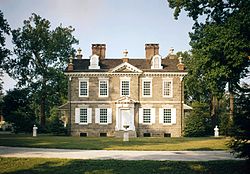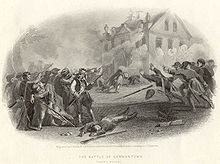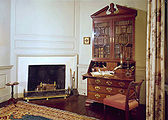- Cliveden (Benjamin Chew House)
-
This article is about Cliveden in Pennsylvania, United States. For the British mansion, see Cliveden.Cliveden

Location: 6401 Germantown Avenue
Germantown, Philadelphia, Pennsylvania, USACoordinates: 40°2′46″N 75°10′56″W / 40.04611°N 75.18222°WCoordinates: 40°2′46″N 75°10′56″W / 40.04611°N 75.18222°W Area: 5.4 acres (2.2 ha) Built: 1763–1767 Architect: William Peters Architectural style: Georgian colonial Governing body: The National Trust for Historic Preservation NRHP Reference#: 66000677[1] Added to NRHP: 1966 Cliveden (pronounced /ˈklɪvdən/, US dict: klĭv′·dən), also known as the Benjamin Chew House, is a historic mansion in Germantown, Philadelphia, Pennsylvania. It was the scene of some of the bloodiest fighting of the Battle of Germantown, fought in 1777 during the American Revolutionary War.
Built between 1763 to 1767, by Benjamin Chew, Esq, the mansion was inhabited from colonial times by seven generations of the Chew family, until 1972.[2] Benjamin Chew was head of the Pennsylvania Judiciary System under both Colony and Commonwealth, and Chief Justice of the Supreme Court of the Province of Pennsylvania. From his legal mentor, Andrew Hamilton, Esq, Chew inherited his lifelong clients, the descendants of William Penn.
When Chew was forcibly removed from his house by the Executive Committee of the Continental Congress, prior to Chew's friend, George Washington's attack on British forces in the area, British Colonel Musgrave quickly occupied the sturdily-built mansion and fought off the attack from inside with muskets and bayonets. Washington's army was repelled and sent back down Germantown Avenue in defeat.
House and Property
In 1966, Cliveden was designated a National Historic Landmark, part of the Colonial Germantown Historic District.[3] The National Trust for Historic Preservation operates Cliveden as a historic house museum, and offers tours from April through December. Significance:
Cliveden is an outstanding example of Philadelphia Georgian architecture. Probably designed by Chew and Jacob Knor, a master carpenter, the stone masonry house has particularly fine interior woodwork.The original estate included a number of other structures, including a stable and coach house, a smoke house, hen house and summer house. The landscaping features stauary and gardens with over 200 varieties of trees and scrubs. In 1868, a two-story addition was added in the original courtyard. A window on the second floor stair landing in the main house was converted into a hidden doorway to create an entrance to the addition.
The Chew Family Papers, containing an extensive collection of correspondence, documents, financial records and other materials, are available for research use at the Historical Society of Pennsylvania.
- Architectural details
External links
- Cliveden of the National Trust
- Cliveden at USHistory.org
- Cliveden's listing as a National Historic Landmark
- Exterior view of the building at the Library of Congress
- You Tube, Growing Up at Cleveden
- Benjamin Chew, Esq. A site dedicated to emerging research on Benjamin Chew, Esq.
References
- ^ "National Register Information System". National Register of Historic Places. National Park Service. 2009-03-13. http://nrhp.focus.nps.gov/natreg/docs/All_Data.html.
- ^ Marion, John Francis. Bicentennial City: Walking Tours of Historic Philadelphia. Princeton: The Pyne Press, 1974.
- ^ Jenkins, Charles F. The Guide Book to Historic Germantown. Germantown Historical Society, 1973.
- ^ Listing, drawings, and photographs at the Historic American Buildings Survey
Categories:- Historic district contributing properties
- Biographical museums in Pennsylvania
- Georgian architecture
- Historic house museums in Pennsylvania
- Houses in Philadelphia, Pennsylvania
- Houses on the National Register of Historic Places in Pennsylvania
- Museums in Philadelphia, Pennsylvania
- National Historic Landmarks in Pennsylvania
- National Register of Historic Places in Philadelphia, Pennsylvania
- Houses completed in 1767
- Reportedly haunted locations in the United States
Wikimedia Foundation. 2010.





